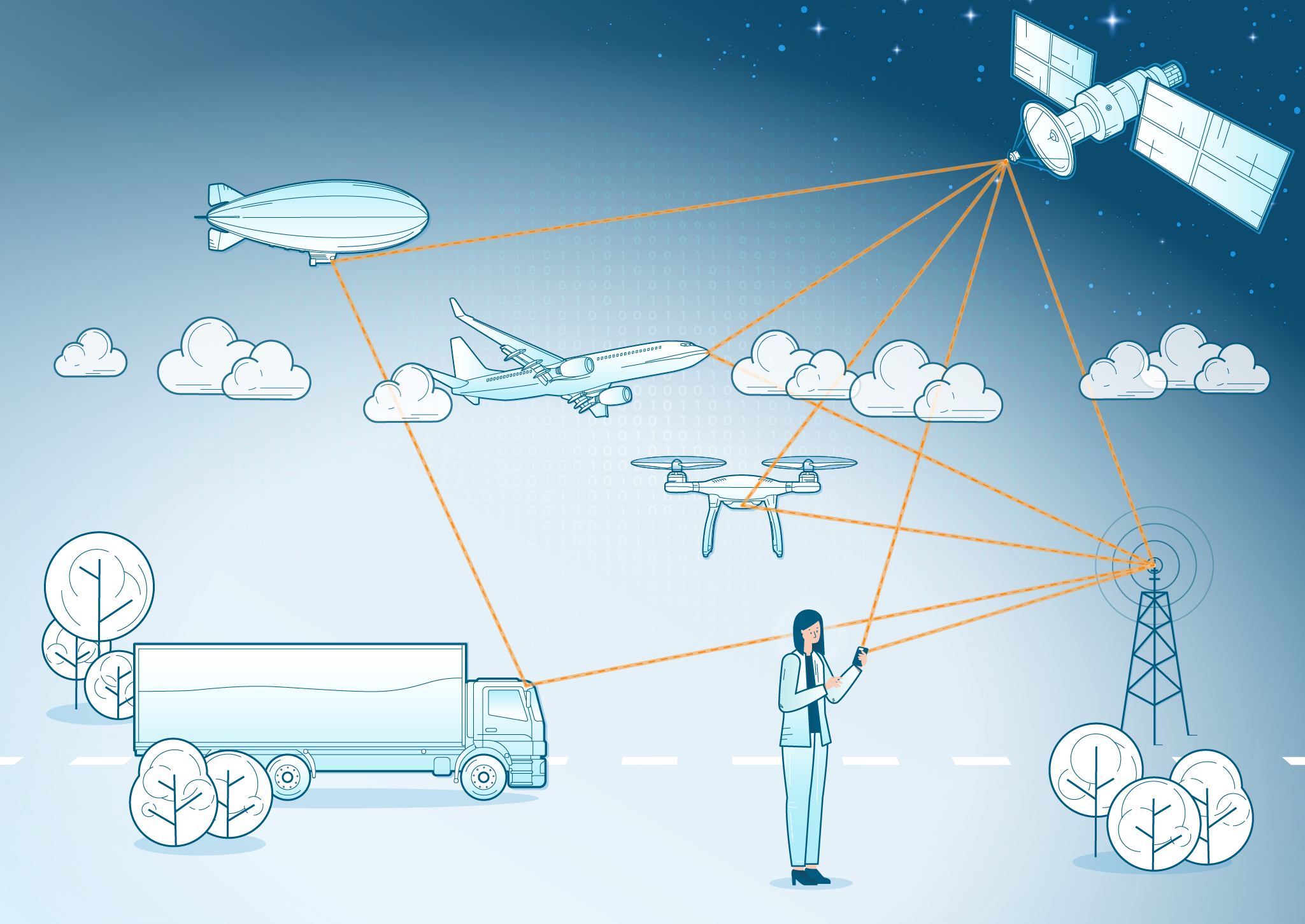5G is giving the convergence of terrestrial and satellite-based networks a major boost. Under the keyword "Non-Terrestrial Networks (NTN)", satellites are being consistently integrated into the mobile communications standard for the first time, subsequently paving the way for a global and dense communication network in the future 6G generation. Both sides benefit from this: not only does it mean terrestrial cellular networks can count on satellite support to overcome any range limitations, it also gives the satellite industry the opportunity to expand its offering of services far beyond the provision of satellite TV and internet. For example, the automotive industry and the Internet of Things benefit from seamless connectivity with NTN.
5G and 6G Satellite Integration
The traditional method, backhaul, involves using satellites to connect cellular base stations on the ground. Satellite backhaul is what connects base stations in remote areas to the cellular network, if necessary, without any additional infrastructure. By serving as connection points between cellular base stations on the ground, satellites establish a global communications network that can make a significant contribution to a fast roll-out of globally available 5G connectivity. This type of networking has already been established since 4G, but will only be anchored in the standard within 3GPP with 5G. The backhaul approach also requires that a terrestrial base station is always available nearby.
New ways to connect – 5G direct access via satellite
At Fraunhofer IIS, we go one step further and focus specifically on the development of technologies for direct communication between satellites and users’ devices as a way to gradually combine terrestrial and satellite-based communication systems.
These newer concepts for integrating satellites into the terrestrial 5G infrastructure are based on direct connectivity between satellites and 5G-enabled user equipment (UE) such as smartphones or vehicles. These devices then have access to the 5G network at all times – even when there is no terrestrial base station nearby. Smartphones or vehicles are thus able to establish a connection via a cellular base station or directly via satellite, depending on the reception situation. Future network architectures are also possible in which the satellite itself, either fully or partially, serves as a base station (gNB).
Especially in combination with various satellite operators’ recently launched or planned constellations, comprising a large number of smaller satellites in low orbit, the integration of satellites into the 5G network offers great opportunities for reliable and global cellular coverage without any gaps. One example of this is the satellite constellation IRIS² (Infrastructure for Resilience, Interconnectivity and Security by Satellite) initiated by the European Union.
Looking into the future: satellite integration in 6G
With 6G, the previous terrestrial networks expand into a three-dimensional structure in which communication on the ground, in the air, and in space merge. Whether base stations, cars, drones, planes, High Altitude Platforms (HAPS), or satellites – platforms from completely different levels are connected to form a 3D network. Communication thereby becomes not only globally and universally available but also gains resilience.
However, the dynamics of the 3D networks pose an immense challenge. While the architecture in the past remained static on the ground, in the future the individual elements will be in constant motion. Therefore, our research is currently focusing on the development of a 6G-capable system-level simulator, in which the complex processes of the 3D networks can be reproduced.
On top of this, we want to ensure the sustainability of the 6G networks. To achieve lower signal peaks and even better performance ratio in future transmission methods, we are researching a more energy-efficient waveform that will enable the power-limited satellites to reach the highest possible data throughput.
Reference projects
5G-GOA – 5G enabled ground segment technologies and over the air demonstrator via GEO satellite
5G-GOA – 5G enabled ground segment technologies and over the air demonstrator via GEO satellite
The objective of the 5G-GOA project is the development and implementation of necessary 5G New Radio modifications according to the 3GPP standardization of 5G NTN in order to enable direct radio access of terrestrial communication networks via GEO satellite. The project is funded by the European Space Agency (ESA).
Fraunhofer IIS provides new software developments for the 5G-enabled prototypes of the base station (gNB) and the mobile end devices (UE), both based on OpenAirInterface.
5G-IS – 5G system infrastructure study
5G-IS – 5G system infrastructure study
The study 5G-IS, which is funded by the European Space Agency ESA (Directorate of Telecommunications and Integrated Applications TIA) addresses the huge potential of satellite-based 5G and beyond services for global connectivity and their infrastructural requirements.
Fraunhofer IIS brings its expertise in 5G satellite integration to this project.
5G-LEO – OpenAirInterface™ extension for 5G satellite links
5G-LEO – OpenAirInterface™ extension for 5G satellite links
In the 5G-LEO project, funded by the European Space Agency ESA, Fraunhofer IIS works with partners in order to extend the OpenAirInterface (OAI) open source code to support satellite systems in non-geostationary orbits. This extension will implement a full 5G protocol stack (Release 17) for both the user equipment (UE) and the base station (gNB). The main outcome of this activity will be a publicly available updated version of the OAI software library with new features to simulate and to test 5G communication links over satellites in low earth orbit (LEO).
5G METEORS – ESA makerspace for 5G and satellite communication
5G METEORS – ESA MakerSpace for 5G and satellite communication
5G METEORS, funded by the European Space Agency (ESA), addresses a broad range of challenges in the 5G and satellite convergence and integration domain, specifically for the direct usage of 5G New Radio over satellites. The program funds several smaller activities comprising the implementation and demonstration of 5G direct access over satellites.
Fraunhofer IIS provides technical support for the coordination of the 5G METEORS program and contributes with 5G NTN technology demonstrations.
6G SENTINEL – Six-G Enablers: Flexible Networks, THz Technology and Integration, Non-Terrestrial Networks, SidElink, and Localization
6G SENTINEL – Six-G Enablers: Flexible Networks, THz Technology and Integration, Non-Terrestrial Networks, SidElink, and Localization
6G SENTINEL is a Fraunhofer lighthouse project. Through its lighthouse projects, the Fraunhofer-Gesellschaft sets strategic priorities to develop specific solutions that will benefit German industry. In the 6G SENTINEL project, five participating Fraunhofer Institutes are developing key technologies for the impending 6G mobile communications standard.
One focus of Fraunhofer IIS is on system level simulations for future hybrid networks in order to comprehensively test the integration of satellites into 6G mobile networks.
6G-SKY – 6G for Connected Sky
6G-SKY – 6G for Connected Sky
In the 6G-SKY project, solutions for the next generation of mobile communications are being developed to ensure reliable and robust networking on the ground and in the air. 6G-SKY is funded by the German Federal Ministry for Economic Affairs and Climate Action in the framework of the European research initiative CELTIC-NEXT.
Fraunhofer IIS leads the German project consortium, advances 6G system level simulations and participates in technology demonstrations of 6G links via satellite and terrestrial 6G links.
TRANTOR – 5G+ evoluTion to mutioRbitAl multibaNd neTwORks
TRANTOR – 5G+ evoluTion to mutioRbitAl multibaNd neTwORks
The project TRANTOR, funded by the European Commission, aims to investigate the suitability of different techniques to prepare 6G satellite integration. The focus is on multi-orbit and multi-band architectures, as well as the associated challenges such as multi-connectivity. In addition to various developments in the ground segment, prototypes will be verified in orbit.
Fraunhofer IIS is also investigating the option of partially deploying the base station into space. A demonstration is planned on the Fraunhofer On-Board Processor (FOBP), which has been developed as an experimentation platform for the Heinrich Hertz satellite.

